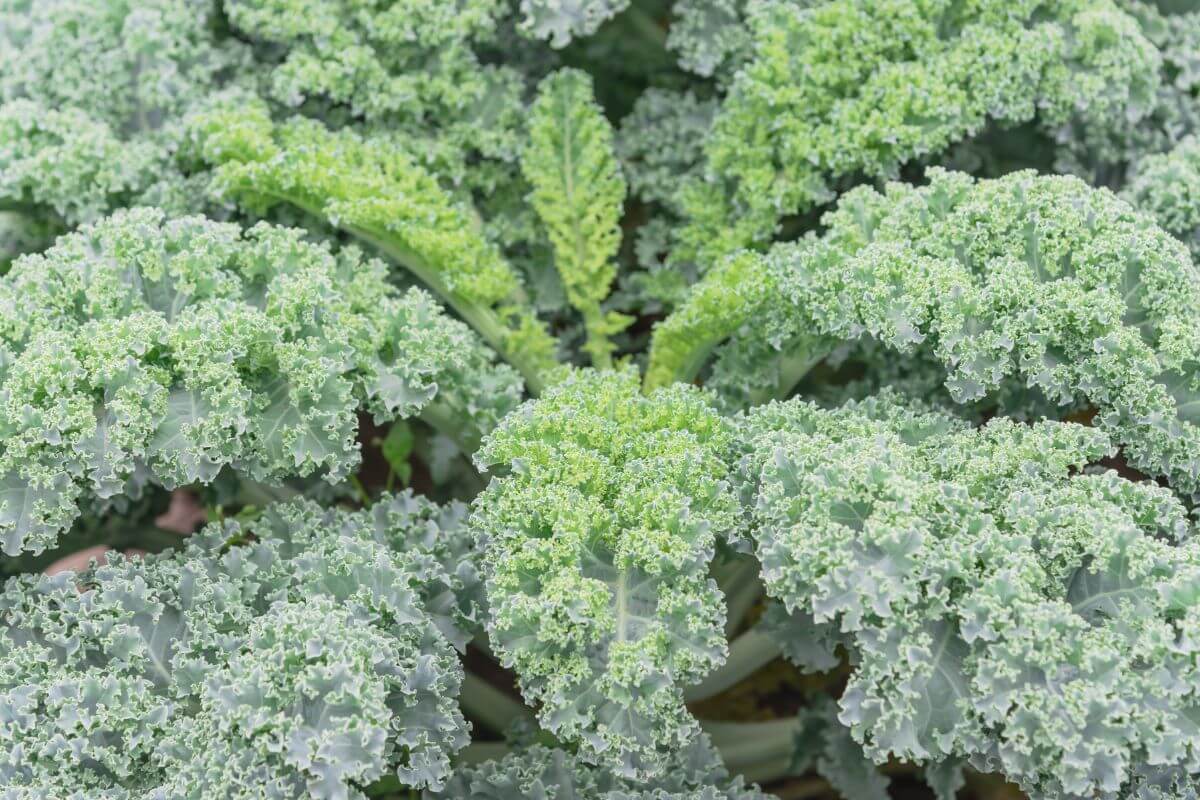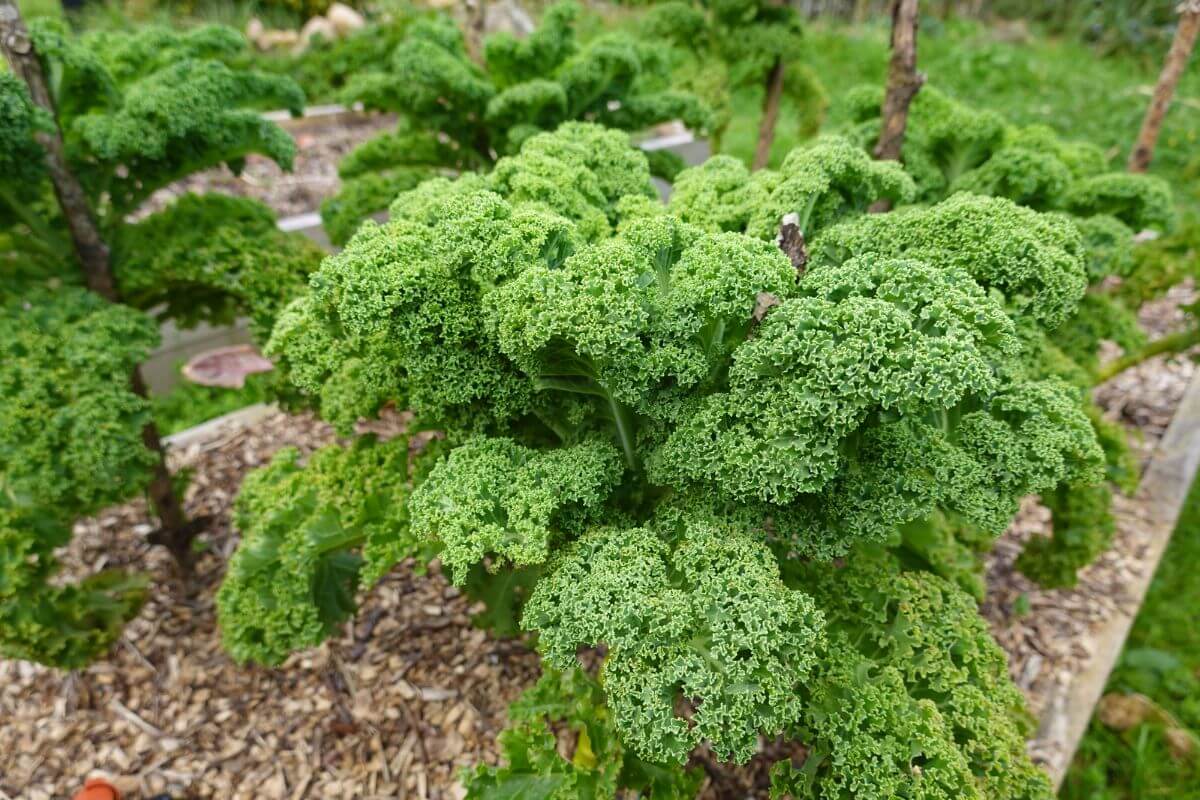Kale is King of the superfoods. Packed with nutrients, antioxidants and vitamins – if you’re not growing it already maybe you should be!
Raw kale is delicious in salads and smoothies, or as a cooked addition to your roast dinner. You won’t be short of ways to eat this healthy crop.
Kale is available in many varieties, including ornamental types that are a beautiful addition to your organic garden.
In this article, I talk about different kale varieties and how to grow, care for, and harvest Kale.
Popular Kale Varieties

There are several varieties of kale available today: Curly Kale (Winterbor Kale), Red Russian Kale, Lacinto Kale (Dinosaur Kale, Tuscan Kale), Chinese Kale, Ornamental Kale, Baby Kale, Siberian Kale, and Redbor Kale.
All these types of kale grow very quickly and produce lots of tasty leaves. They are easy to grow and maintain, and require little care once established.
- Curly Kale (Winterbor Kale, Scot’s Kale) – Curly kale is what most people think of when they think of ‘kale’ because it’s what you’ll find in supermarkets the most. These are great for salads.
- Lacinto Kale (Dinosaur Kale, Tuscan Kale) – These are known for its long, flat, and dark green leaves. People like to eat this with salads or even raw.
- Red Russian Kale – Originating from Russia, this kale has wide green leaves with a purple stem. It’s known for its sweet flavor.
- Chinese Kale – Chinese Kale are also named Chinese Broccoli. They have large, round leaves that are reminiscent of broccoli leaves.
- Ornamental Kale – These ornamental kale varieties are mainly grown for their decorative, purple or white leaves. They don’t taste that great like the other kale types.
- Baby Kale – Baby kale is often used with other salad greens. It’s harvested when kale plants are still young.
- Siberian Kale – Named Siberian Kale because they’re the most cold-resistant kale varieties. These are popular in kale salads.
- Redbor Kale – This kale is known for its deep red, purple coloring on its frilled leaves. It’s a great complement to green salads with its crisp flavor.
Site and Organic Soil Preparation for Organic Kale
Kale needs moist, but well-draining soil that is in full sunlight or partial shade. Full sun means six or more hours of sun per day, partial shade takes it down to four to six hours in the sunlight.
If you’re growing in a warm climate, ensure that your kale is in partial shade, as kale does prefer it a bit cooler rather than too hot.
Dig plenty of organic matter into your soil before planting and consider growing them in raised beds to aid in drainage.
Kale can also be grown in pots. It’s super easy to grow, so it’s great for beginners or those who are limited on space.
Planting Organic Kale
Kale seeds should be sown from February to June. You should sow a few every couple of weeks to stagger your harvest. In cold weather, start them in modules and transplant them in about 6-8 weeks.
Once the last frosts have passed, you can sow them directly outside. Plant kale seeds about 1/2 inch deep and at least 6 inches apart. When you thin out your plants, you can use the thinnings in salads.
Kale is a biennial, meaning they will flower in their second year before going to seed. If you’re planning on seed saving, you’ll have to take this into account and leave a few plants to overwinter and flower in the spring. Kale seeds will last up to four years.
Growing Organic Kale

Kale is pretty close to its wild ancestors, and doesn’t really need much looking after. I’ll deal with pests and disease in the next section, so here are three things you need to know for growing kale.
- Keep kale well watered. A good mulch on top of the soil will suppress weeds and help keep the soil moist.
- Flat leaved kale does not like to transplanted, and so they should be sown directly where they are going to grow.
- With proper harvesting and care, kale can continue to grow and produce edible leaves for years.
Kale can be overwintered and can deal with cold temperatures. Although, if you’re having a particularly harsh winter, you could cover the plants with straw to keep them warm.
If you’re growing in pots, the soil will get much colder than if it were in the ground, so insulate the pots or bring them into a greenhouse.
Pests and Diseases Affecting Organic Kale
Kale is pretty hardy, which is another good reason for growing it. It won’t succumb to many pests. Regular harvesting will disturb bugs and prevent them from taking the tastiest leaves.
Keep an eye out for caterpillars and aphids. You shouldn’t get many, so pick caterpillars off by hand, and a good jet spray of water should knock off any aphids.
To control cabbage worms, pick them off by hand and squish them, or use Bacillus thuringiensis (Bt) if you have a large infestation.
The biggest problem you’ll face is birds, so put up some bird scarers or cover your plants with a net.
Kale is susceptible to some fungal diseases, usually due to a build up in the soil. If you get any issues, you should try to remove the plants and rotate your crops. Kale is part of the brassica family, so you should plant legumes in the same spot the following year after kale.
Harvest and Store Organic Kale

Kale is a great plant for harvesting and can give you fresh greens all year. Young kale leaves can be used in salads and you can also leave them to mature for winter greens.
You can begin harvesting around 70-80 days after you plant the seed. With continual harvesting from your kale plant, you can keep them healthy and productive.
Harvest the older leaves from the bottom and the plant will continue to produce new leaves at the top. Cut them off close to the stalk with a sharp knife or scissors.
If you do want to harvest the young leaves from the top, be aware that this may stunt the plant’s growth. However, it will encourage side shoots, so depending on your space, this is also a viable option.
If the kale leaves turn yellow, it means you need to harvest more often as the leaves have over ripened.
Kale is best used fresh, so pick the leaves as you need them. If you have too many to eat and want to store them, then the leaves can last for 1 to 2 weeks in the fridge in a plastic bag. They can also be dried, canned, or blanched and frozen.
Growing Organic Kale Final Thoughts
Kale is a great organic crop for both beginners and seasoned gardeners. It is so easy to grow, resistant to most pests and very prolific.
Healthy and nutritious, it had a variety of uses from summer salads to winter soups. It will provide you with fresh leaves from summer, through winter to spring.
Its flowers can be a vital source of nectar for bees in the early spring, although if you want to keep your plants for food rather than seed, you should pinch out any buds before they flower.
As you can harvest from the plant without pulling it up, you can viably keep some plants for leaves and some for seeds, providing those early pollinators with a valuable resource. Attracting pollinators to your organic garden is as beneficial to you as it is for them.
My advice is to just start growing kale!
- Related Article: How to Save Seeds
As you start and expand your organic garden, look at growing other organic herbs and vegetables:

